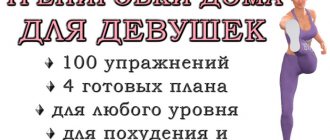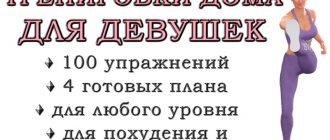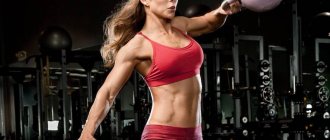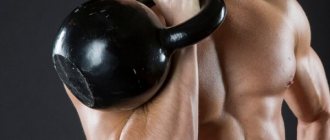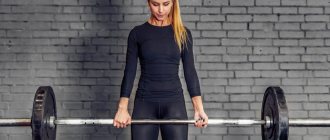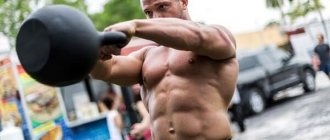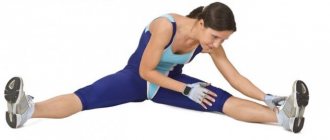Most people associate a tourniquet with a first aid kit, bleeding, and other medical history. And, by the way, this is also a great sports equipment that will help you get in shape after winter! Wrestlers, boxers, skiers and other athletes have been using a rubber tourniquet in their training for a long time and productively.
I suggest you join the athletes, because exercises with this equipment are suitable even for beginners, and the results will not keep you waiting. And now I’ll tell you how to get the best result.
What it is?
This is not know-how: the rubber expander has long been in service with rehabilitation specialists, who use it to restore athletes after injuries. A modern sports harness is a flat or round piece of multi-layer latex with or without handles at the ends, which allows you to diversify your workouts and make them more effective. In one of the variations, the simulator is also used for swimming.
Full body exercises with bands
In the vast majority of cases, training bands are held in place by one or both legs.
Shoulders
- Military press with tourniquets : the tourniquet is held by the feet, the arms are straightened upward, as in the military press with a barbell.
- Abduction of straight arms forward and to the sides - isolating exercises for the front and middle bundles.
- Pull to the chin - partially relieves tension from the neck muscles.
- Pulling your arms back : to do this, take a position with your supporting leg in front and a tourniquet under it, your body tilted forward (supporting foot and shoulders on the same vertical). We pull back with our hands, concentrating on the tension in the rear deltoids.
Hands
- Biceps:
- standing arm curl;
- bending arms while standing one at a time (hammer);
- concentric bending of the arms one at a time - performed while sitting, when performed on the left arm, the tourniquet is held by the left leg and vice versa.
Complete your home biceps routine with resistance band exercises.
- Triceps:
- standing extension - arms move from a right angle to a position straight up;
- extension of the arms downwards - the tourniquet is attached to the horizontal bar;
- Forearm training can also be supplemented with harnesses.
Pectoral muscles
- Additional load during push-ups : the tourniquet is passed over the shoulder blades and held with your hands. You can do push-ups with both wide and narrow arms.
- Wiring : it is necessary to secure the loops on the horizontal bar behind your back. Keep your elbow joints still to avoid injury.
Back
- Deadlift : Requires a heavy load to be effective - layer the bands.
- Belt row : similar to the bent over dumbbell row - it develops the width of the back well.
More exercises for back training here.
Press
- Loaded crunches : attach the tourniquet behind your head, for example to the leg of a chair, and do crunches while holding the loop with your hands.
Read our article on how to achieve sculpted abs.
Legs
- Squats : the middle of the tourniquet is placed on the neck, the ends are pressed with the feet, after which squats are performed. The length of the rubber should not be too long.
- Roman deadlift : The starting position is similar to the deadlift, however, during the execution, the legs are not bent and the tension is concentrated on the back of the thigh.
- Lower leg : the location is similar to squats, you can perform it with either two or one leg.
As you have already noticed, using harnesses you can perform any exercise and pump up your entire body.
Advantages
Practice shows that the less sophisticated a thing is, the more useful it is. It’s the same with a burn: it won’t be able to harm you, but it will give you a lot of bonuses:
- It will help to work usually inactive muscles, as well as to work specific muscle groups in isolation.
- It will give an increasing load: the more you pull it, the more force you need to apply (unlike iron).
- Allows you to vary the load: elastic bands of different elasticity will simplify or complicate ordinary exercises (for example, lifting a barbell or pull-ups).
- Thanks to its small dimensions, it is easy to take it with you anywhere: even to the country house, even to the ocean. And training with a tape does not require a lot of space.
- And, of course, accessibility: the stores have plenty to choose from for every color and budget.
Rubber bandage
+ Possibility to purchase at any pharmacy and specialty store, low price.
– There is no change in load by selecting a stronger resistance; you will have to “play” with the length and layers.
The load when working with harnesses is increasing, which is practically unattainable when working with iron. This is the main advantage after accessibility.
Precautionary measures
This projectile has one functional feature - there is always a possibility of breakage, so it is worth monitoring the condition by inspecting your hinges for wear.
If any defects appear, you should immediately replace the rubber training bands with new ones. Also during exercise, exercises with traction on the head are dangerous.
How to choose the right one
Which tourniquet to use depends directly on your goals and current physical fitness. If you decide to make your home workouts a little more challenging, a rubber band will suit you well, with which you can exercise just as productively as with a branded elastic band.
If you are going to exercise in the gym, consult with a trainer before purchasing professional equipment. Branded harnesses are available in different colors, lengths and elasticity. When choosing a projectile, pay attention to the numbers indicated on it: the first will mean the minimum, and the second will mean the maximum force that needs to be applied to stretch the rubber.
Training programs
The following programs are tailored for development of 3 main functions.
Program No. 1. Gaining muscle mass, developing performance, improving shape.
Workout #1. Back, pectorals, deltoids
| Exercise | Rubber color (resistance) | Approaches | Repetitions | Rest after approach in minutes | Rest minutes after exercise |
| Bent-over harness pull | Purple (12-36) | 4 | 12 | 1 | 3 |
| Standing harness press | Purple (12-36) | 4 | 10 | 1 | 3 |
| Raising your arms in front of you | Purple (12-36) | 3 | 12 | 1 | 3 |
| Push-ups with a tourniquet | Red (5-22) | 3 | 10 | 2 | 3 |
| Traction of a tourniquet to the stomach while sitting | Purple (12-36) | 3 | 10 | 1 | — |
Workout No. 2. Legs, buttocks, arms, abs
| Exercise | Rubber color (resistance) | Approaches | Repetitions | Rest after approach in minutes | Rest minutes after exercise |
| Squats with a tourniquet | Green (17-54) | 5 | 20 | 2 | 3 |
| Lunges with a tourniquet | Green (17-54) | 3 | 12 | 1 | 3 |
| Arm Curl | Red (5-22) | 3 | 12 | 1 | 3 |
| Arm extension | Red (5-22) | 3 | 12 | 1 | 3 |
| Press jumps | Red (5-22) | 3 | 15 | 1,5 | — |
Program No. 2. Losing weight, developing endurance
Workout #1. Back, pectorals, deltoids
| Exercise | Rubber color (resistance) | Approaches | Repetitions | Rest after approach in minutes | Rest minutes after exercise |
| Bent-over harness pull | Orange (2-15) | 6 | 12 | 1 | 3 |
| Standing harness press | Orange (2-15) | 6 | 1 | 1 | 3 |
| Raising your arms in front of you | Orange (2-15) | 3 | 12 | 1 | 3 |
| Push-ups with a tourniquet | Without rubber | 3 | 15 | 1 | 3 |
| Traction of a tourniquet to the stomach while sitting | Orange (2-15) | 3 | 10 | 1 | — |
Workout No. 2. Legs, buttocks, arms, abs
| Exercise | Rubber color (resistance) | Approaches | Repetitions | Rest after approach in minutes | Rest minutes after exercise |
| Squats with a tourniquet | Orange (2-15) | 7 | 20 | 1 | 3 |
| Lunges with a tourniquet | Orange (2-15) | 3 | 15 | 1 | 3 |
| Arm Curl | Orange (2-15) | 3 | 15 | 1 | 3 |
| Arm extension | Orange (2-15) | 3 | 15 | 1 | 3 |
| Press jumps | Orange (2-15) | 3 | 15 | 1 | — |
You can add circuit training here.
| Exercise | Rubber color (resistance) | Repetitions | Rest (in seconds) after exercise |
| Squats | Red (5-22) | 12 | 15 |
| Bent-over row | Red (5-22) | 12 | 15 |
| Push-ups with rubber band | Orange (2-15) | 8 | 60 |
We perform this program 3-4 times without stopping - we do 3-4 circles.
Program No. 3. Development of strength, strengthening of the musculoskeletal system
Workout #1. Back, pectorals, deltoids
| Exercise | Rubber color (resistance) | Approaches | Repetitions | Rest after approach in minutes | Rest minutes after exercise |
| Bent-over harness pull | Blue (23-68) | 3 | 5 | 2 | 4 |
| Standing harness press | Blue (23-68) | 3 | 4 | 2 | 4 |
| Raising your arms in front of you | Purple (12-36) | 2 | 12 | 1 | 3 |
| Push-ups with a tourniquet | Blue (23-68) | 3 | 4 | 2,5 | 3 |
| Traction of a tourniquet to the stomach while sitting | Purple (12-36) | 2 | 12 | 1 | — |
Rubber loops: where to buy
Rubber loops have several levels of resistance, each of them has its own color and a specific band width. The resistance level has an equivalent in kilograms, but since the muscle load from the elastic band and free weights is different, the ratio will be quite approximate.
Types of rubber loops according to load:
- Red color: 7-10 kg (band width 1.3 cm)
- Black color: 10-20kg (band width 2.2cm)
- Purple color: 22-35kg (band width 3.2cm)
- Green color: 45-55 kg (band width 4.4 cm)
- Blue color: 55-80 kg (band width 6.4 cm)
Red and black colors are usually used for training small muscle groups: biceps, triceps, deltoids. Purple, green and blue colors are used for training large muscle groups: chest, back, legs. The load is adjusted depending on your capabilities and strength training.
A wide variety of rubber loops at affordable prices is offered by the online store Aliexpress . You can purchase a set of loops or choose 1-2 bands of a specific resistance. We have selected popular products with good reviews and a large number of orders so that you can purchase quality equipment. It is also better to additionally read customer comments before purchasing.
Very often there are discounts on products, so the price indicated in the review is not final.
Set of rubber loops of different resistance
Usually the set includes 3-5 tapes of different resistance. For training the whole body, it is better to purchase a set of rubber bands, since large and small muscles require different loads. The cost of a set of tapes is usually in the range of 2000-3000 rubles.
1. J-Bryant rubber loops (3 sets of options)
- Option 1
- Option 2
- Option 3
2. Kylin Sport rubber hinges (2 sets of options)
- Option 1
- Option 2
3. Winmax rubber hinges
4. ProElite rubber hinges
5. Jumpfit rubber loops
Lunges with body rotation and arm extensions
Start with your arms extended in front of you at shoulder level and hold the band at shoulder width. Take a wide step back with your right leg and perform a squat until both legs are bent to a right angle (the upper thigh of your left leg should form parallel to the floor). In a lunge, turn your body to the right, while using your abdominal muscles and spreading your arms with an elastic band to the sides . As you exhale, return your body back to the center and stand in the starting position. Repeat the same on the other leg.
Types and sizes of rubber bands
Tape expanders (fitness bands) are made from:
- polyurethane;
- rubber;
- latex;
- combined fabrics.
The fitness elastic band, which has successfully replaced the expander, enhances some of the exercises performed outside the gym. Exercises with such a device have a more effective effect on the abs than, for example, an ordinary load without any equipment. The level of weight with such a projectile is quite noticeable.
Dense and stretchable sports equipment is suitable for developing any muscles. It increases the load when exercising with a strength bias.
The table below describes what types of fitness bands are found in the sports trade:
| Types of rubber bands | Characteristics | Properties |
| Tubular expander with handle holders | Wear-resistant latex tube with plastic handles and length up to 130 cm. | Can replace dumbbells; Trains the core muscles; prevents diseases of the lower back and back. |
| Elastic tape | Length up to 2.5 m, sold in rolls, from which the required sizes are cut. | The projectile enhances the effectiveness of exercise and burns calories |
| Extended loop | Width from 1 to 9 cm | It can be coordinated several times, and then practiced. |
| Mini loop | Multi-layer rubber band with a width of up to 10 cm, circumference diameter – 60 cm. | Do not injure limbs and body. |
Warm-up with an elastic band[edit | edit code]
Source: “Cross-training”
Author:
instructor O.B. Derval, 2016
Do the exercises one after another. Do 2-3 sets, taking 30 seconds to 1 minute rest
- 10 jumping jacks with leg extensions
- 20 vertical arm swings in the lateral plane
- 10 lateral tape pulls with two hands, alternating sides
- 5 exercises in a sitting position + jumping jack
- 3 sets, 30 second recovery
- Jumping with legs spread, vertical swings of arms in the lateral plane
- Lateral band pulls with two hands with alternating sides, exercises in a sitting position + jumping jack
Periodization
Cycling hard workouts with light ones. Periodization is needed for:
- Accelerate recovery
. Light training accelerates the recovery of injured muscles and prevents loss of physical and psychological tone; - Reducing the load on the nervous system
. Heavy training depletes the central nervous system and leads to overtraining; - Improving the performance of experienced athletes
. The rate of progress slows down over time, the body is not ready for linear progress, and a training plateau sets in. For experienced athletes, periodization is a tool that can help them take a few more steps forward without the use of illegal drugs.
Periodization is a technique for athletes with at least 6 months of experience.
Standard cycling is alternating heavy workouts with a 50% load.
Standing back leg raise
Stand hip-width apart and place the Crossband around your right leg, holding it with your left hand. Shift your weight to your right leg and lift your left leg, extending it all the way back (as if drawing a T). Bending over, pull the band towards you (towards your chest), bending your elbow at a right angle. Then return to the starting position. Do a few reps and switch sides.
Rubber in the form of a loop or with handles?
There are expanders of various shapes. Some are made in the form of a circle, others - in the form of a piece of rubber cable (sheath) with many flagella inside, at the ends of which handles can be attached for easy grip.
Rubber loops have greater resistance, which is why they are often used in professional sports or the gym. The harnesses are designed for the needs of aerobic gyms, functional training and home workouts. They are quite enough to work out all muscle groups and lose weight.
How to use tourniquets safely and correctly
To ensure that the training does not go down the drain and brings maximum effect, you need to remember a number of nuances:
⇒ between approaches the rest interval is 40-60 seconds;
⇒ do not remove the tourniquets during rest between exercises;
⇒ for tightening, use a tourniquet of about 4-5 cm, but it should not be too tight.
⇒ the time of loading on the trained area should not be more than 2 minutes.
In simple words, using harnesses, the workout should be intense and short. At this time, you can use dropsets and supersets.
How does occlusal training work?
Training with blood flow restriction does not completely block blood flow to the muscles; you block only small capillaries passing through the venous vessels, while blood flows through large arteries to the muscles without interruption.
Thus, the muscles are filled with blood from the arteries, since the venous vessels, due to their small volumes, are not able to quickly pump it back - this is a real double pumping of the muscles!
There are 3 known methods of influencing muscle growth by training with tourniquets:
1) The point of maximum concentration - when the muscles are maximally filled with blood, nutrients are retained in the muscle tissue and the muscles only need to explode or grow further, but since it does not explode, everything goes towards increasing volumes.
2) Muscle oxygenation - allows large muscle areas to be included in the work as much as possible, which automatically contributes to the anabolic effect.
3) Oxygen limitation - a sharp decrease in the access of oxygen to the muscles, stimulates the production of lactic acid, which improves the absorption of protein, and this is the building material for muscle fibers.
It is useful to use this training method during recovery from injury, as a transition period to prepare for regular training with working weights.
The principle of load progression
This is the thing without which training with loops can only keep you in shape. The principle states: an athlete must regularly increase training stress and adapt the body to new loads. Regularity depends on:
- Gender and age
. Men are able to progress faster than women. Teenagers are faster than men aged 30-40 years. Adult men are faster than older people; - Training experience
. Beginners (up to six months of training) can increase the load in each lesson and train often. The more experience, the less often you train, and the less often you will be able to increase the load. Most people won’t need this: after a few years of training, we get the body of our dreams. After that we work on the details, maintain the shape; - Stress levels in everyday life
. Workout programs should take into account your life outside of your home gym. The more stress there is in life, the less stress there is in training; - Compliance with the daily routine, rules of proper nutrition
. A correct daily routine and proper anabolic nutrition are the basis of progress. - The work of the hormonal system, the health of the body
. The worse your health, the less likely you will be able to progress.
The average indicator is compliance with the principle of progression of loads every 1-4 similar workouts. The indicator may change depending on changes in the values of variables. Example: in case of high physical or psychological stress, it is necessary to slow down the progress so that the body can digest the load and not fall into overtraining.
We increase the load by increasing the resistance of the loops, the number of approaches and repetitions. We add new exercises with loops, reduce the rest between approaches and exercises.
Body rotation
Lie face up on the floor with your arms extended above your head and a resistance band between your wrists . Raise your arms and legs off the floor and use your abdominal muscles to twist to the right, keeping your shoulders straight. Return to the starting position and perform the exercise in the other direction.
Faster, tougher, stronger
A rubber expander allows you to develop all the qualities necessary for an athlete. The loops differ in thickness, which creates the desired resistance. Usually it is indicated on the tape and starts from 7-10 to 100 or more kilograms.
By stretching the rubber to the maximum, you can increase the strength and volume of muscles, increase the power and speed of blows, which is what complexes with a tourniquet for wrestlers are aimed at.
Exercises can be as follows:
- The development of punching power is used in boxing. The expander is fixed on the wall bars, the athlete stands at a distance of two meters with his back to the wall to keep the rubber taut. When performing a strike, additional force will be created, which will help develop both speed and strength;
- Developing throwing power is necessary for judokas. The tourniquet is also fixed on the wall, the wrestler faces it and takes the two ends in his hands. Making a body turn, he throws, pulling the rubber;
- Development of pushing force. The tourniquet is attached as in previous cases, the wrestler stands with his back to it, holding the ends in his hands. Performs a forward push, stretching the rubber as much as possible;
- A universal exercise for freestyle wrestling, judo and sambo. The wrestler stands facing the tourniquet fixed on the wall and holds both ends of it. The legs are shoulder-width apart, the body is inclined. With quick movements, move your hands behind one leg, while simultaneously taking a step to the side. Step back and place your hands behind your other leg.
History of origin
We will not go deep into history, but it is worth noting that the author of the technique, Yoshiaki Sato, a former Japanese doctor, personally developed this technique after an accident. After a skiing accident, he began to independently rehabilitate himself from a hip injury; the muscles were damaged, not the joints.
He remembered that British doctors, in order to speed up recovery, used the method of bandaging with tourniquets in cases of damaged limbs, but this was not widely used, as it was considered banal nonsense.
However, the Japanese took a risk with this technique and used it on himself. Properly selected exercises using rubber bands allowed recovery after 1.5 months, although the doctors’ forecasts were about 6 months.
It was after this that in 1994 he patented a rubber tourniquet for training and gave impetus to the KAATSU method, which means KA-additional, AATSU - pressure.
How to pump up your abs with elastic bands?
The use of fitness bands allows you to increase the effectiveness of training your abdominal muscles. This is achieved primarily by performing rotational movements. These techniques are ideal for advanced exercisers who need extra challenge.
Note that using elastic bands during abdominal exercises allows you to learn to feel the work of the external oblique abdominal muscle. To do this, take a continuous wide elastic band of medium hardness and place it around your waist - this will help “catch” the feeling of conscious tension in the abdominal muscles.
Exercises with elastic bands for women
The benefit of exercises with fitness bands for women is that such training involves slow-twitch muscle fibers. These fibers use free fatty acids rather than glycogen for energy. Training with elastic bands increases the elasticity of connective tissues and helps fight cellulite.
The key focus of anti-cellulite training is to activate the gluteus medius muscle. It is this muscle that gives the buttocks their characteristic roundness - however, it is not used when walking, and requires special exercises for the buttocks.
// Exercises with elastic bands for women
***
Exercises with elastic bands are a way to strength train for men at home. The presence of tight bands and elastic bands with handles will allow you to perform most functional exercises - squats, push-ups and even variations of deadlifts. You can also perform biceps and triceps exercises with fitness bands.
There may be contraindications to performing physical exercises in general - and to performing exercises with fitness bands in particular. Consult a specialist.
Illustrations for the exercises:
- 8 Resistance Band Moves You Need For a Total Body Shape Up, source
